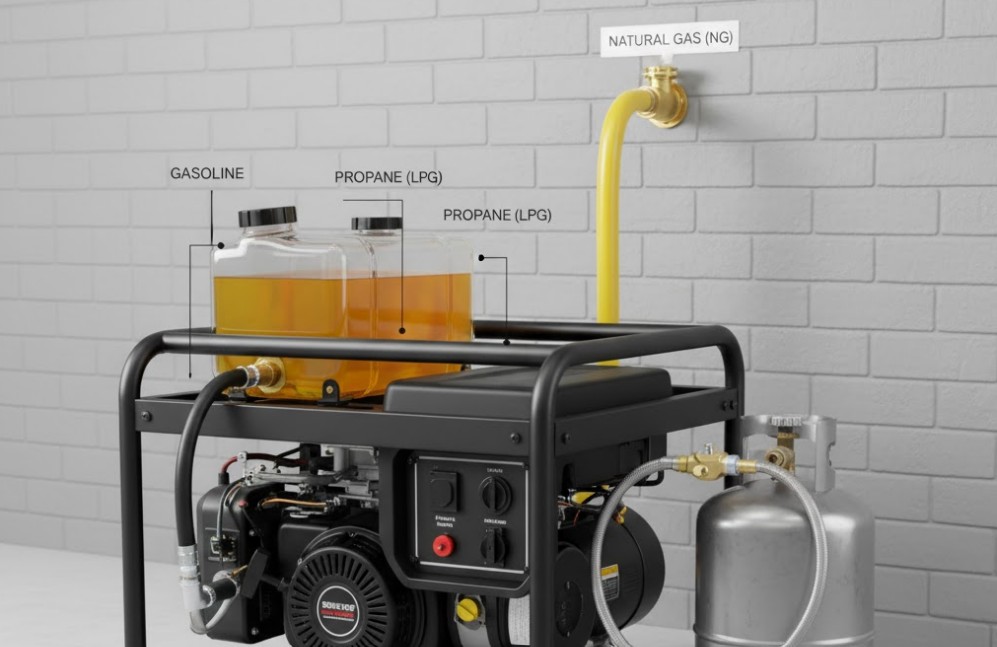In an age where reliable electricity is essential—not just for comfort but for communication, safety, and health—the need for dependable backup power has never been clearer. For decades, the portable generator market was dominated by single-fuel gasoline models. Then came the dual-fuel generator, offering the choice between gasoline and propane (LPG). Today, the gold standard for versatility and long-term emergency readiness is the Tri-Fuel Generator.
A Tri-Fuel Generator is a sophisticated, heavy-duty workhorse capable of running on three distinct fuel sources: Gasoline, Propane (LPG), and Natural Gas (NG). This triumvirate of fuel options fundamentally changes the conversation around home backup power, eliminating the anxiety of a single-source dependency. But what exactly makes these machines so powerful, how do they manage to switch seamlessly between fuels, and are they the right fit for your specific needs? This comprehensive guide will explore the mechanics, benefits, considerations, and maintenance required to master the ultimate in generator fuel flexibility.
What Is A Tri-Fuel Generator? The Three Pillars of Power Reliability
At its core, a Tri-Fuel Generator is an internal combustion engine modified to efficiently utilize three different chemical energy sources. While a standard engine’s carburetor is tuned to handle only liquid gasoline, a tri-fuel model incorporates a sophisticated fuel delivery system designed to manage both liquid fuel and two types of gaseous fuel.
The Anatomy of a Tri-Fuel System
The innovation lies in the specialized carburetor or fuel control system, often combined with a demand regulator for the gaseous fuels. When running on gasoline, the system operates conventionally. When switching to propane or natural gas, the system bypasses the gasoline delivery and introduces the gaseous fuel directly into the air intake manifold (or the venturi area of the carburetor). This is managed by specific components:
- Fuel Selector Valve: A manual or electronic switch that isolates one fuel line while activating the appropriate regulator and gas port for the chosen fuel.
- Demand Regulator: This critical component reduces the high pressure of the incoming propane or natural gas (especially for NG, which comes from the household line) to the very low pressure required by the engine’s intake system. It only allows gas to flow when the engine creates a vacuum, ensuring safety and efficiency.
- Specialized Carburetor: Unlike gasoline-only units, the tri-fuel carburetor is engineered with additional ports and pathways to accurately mix the incoming gaseous fuel with air, ensuring the engine runs smoothly and efficiently on all three sources.
In essence, the generator maintains the ability to run on liquid gasoline while gaining the capacity to “sip” on propane from a tank or connect directly to a household natural gas line. This provides an extraordinary degree of fuel flexibility—the single biggest advantage of the technology.
Tri-Fuel vs. Dual-Fuel: The Ultimate Fuel Flexibility and the Natural Gas Advantage
Most consumers are familiar with dual-fuel generators (typically gasoline and propane). While dual-fuel models are excellent for providing a backup option, the jump to a tri-fuel system, which adds Natural Gas (NG) capability, represents a monumental leap in long-term preparedness. Natural gas capability is the key differentiator and the main reason why many homeowners opt for Tri-Fuel Generators.
Natural Gas: The Uninterrupted Supply
Unlike gasoline, which degrades over time and requires constant rotation, or propane, which is limited to the capacity of your tanks, natural gas is delivered through underground utility lines. This is a game-changer during widespread, long-duration power outages:
- Unlimited Run Time: As long as the municipal gas utility remains operational (which is common, as their lines are underground and less susceptible to weather events than overhead power lines), your generator has a virtually unlimited supply of fuel. You eliminate the need for refueling trips, which are often impossible or dangerous during emergencies.
- Cleanliness and Longevity: Natural gas is a cleaner-burning fuel than gasoline. This results in significantly less carbon buildup, reducing wear on the engine’s internal components, extending the engine’s overall lifespan, and decreasing the frequency of certain maintenance tasks.
- Convenience: Once connected to the home’s gas line via a professionally installed quick-connect fitting, starting the generator is effortless. No heavy propane tanks to move or messy gasoline cans to pour.
A Comparison of Fuel Types: Power and Shelf Life
When selecting a fuel, it is crucial to understand the trade-offs, particularly in terms of power output. Fuel sources have different energy densities, which means they produce different amounts of power from the same engine volume. You will typically see three wattage ratings listed for Tri-Fuel Generators:
| Fuel Type | Energy Density/Power | Shelf Life | Availability/Convenience |
|---|---|---|---|
| Gasoline | Highest Wattage Output (Baseline) | 3-6 months (with stabilizer) | Highest Power; most portable. |
| Propane (LPG) | Slightly Lower Wattage (approx. 10% loss) | Indefinite (Years) | Easily stored long-term; portable tanks. |
| Natural Gas (NG) | Lowest Wattage (approx. 15-20% loss from gasoline) | Unlimited (Pipeline) | Unlimited run time; requires permanent connection. |
Therefore, while natural gas offers the best long-term reliability and convenience, gasoline will always provide the highest possible wattage from the unit’s engine. Propane splits the difference, offering a cleaner burn and infinite shelf life while still remaining portable.
The Core Tri-Fuel Strategy: Use Gasoline for peak power demand or when maximum portability is needed. Use Propane for clean burn and long-term storage power. Rely on Natural Gas for unlimited run time during prolonged power outages.
Choosing and Powering Your Tri-Fuel Generator: Sizing, Connections, and Conversions
Selecting the right Tri-Fuel Generator requires more than simply choosing the highest wattage number. You must account for the power loss inherent when using gaseous fuels, and ensure your home is ready for the natural gas connection.
Sizing for Gaseous Fuel Output
When shopping for a tri-fuel model, always base your essential appliance load calculation on the natural gas (NG) wattage rating. Since NG provides the lowest output, calculating your needs based on this rating ensures the generator will cover your most critical appliances even during the longest outages.
- If a generator is rated at 10,000 surge watts on gasoline, its NG rating might be closer to 8,000 surge watts. This 20% drop must be factored into your load planning. For models optimized with inverter technology, see options like the tri-fuel inverter generators at this list of best tri-fuel inverter generators.
The Critical Natural Gas Connection
Connecting a portable Tri-Fuel Generator to your home’s natural gas line is not a DIY task for most people, as it requires knowledge of gas pressure, flow rates (BTU/hr), and local codes. Improper installation is extremely dangerous.
- Determine BTU Needs: The generator’s engine requires a specific volume of gas to run. This is measured in British Thermal Units (BTUs). You must ensure your existing home gas line and meter can supply the BTU needs of the generator in addition to your home’s existing gas appliances (furnace, water heater, stove).
- Pipe Sizing and Regulator: A qualified HVAC technician or plumber will need to assess the distance from the meter to the generator’s location and potentially run a larger-diameter gas pipe to maintain the necessary low-pressure and high flow rate (CFH) required by the generator’s demand regulator.
- Quick-Connect Installation: For safety and convenience, a quick-disconnect fitting is installed at the generator site. This allows for fast, secure, and tool-free connection and disconnection of the flexible gas line when the generator is needed or stored.
Converting a Generator to Tri-Fuel
Some users choose to convert an existing single-fuel or dual-fuel generator to tri-fuel using aftermarket conversion kits. This process generally involves replacing or modifying the carburetor and installing the necessary demand regulators and fuel lines. While conversion kits are available—such as the ones mentioned in online discussions—it’s vital to consider two major caveats:
- Warranty Risk: Installing an aftermarket conversion kit will almost certainly void the manufacturer’s warranty on the engine and possibly the entire generator.
- Performance and Safety: Unless the kit is specifically engineered for your model, performance can be heavily compromised, resulting in an even greater wattage loss (sometimes up to 50% or more) and potential safety hazards if gas connections are not properly sealed and regulated. For maximum safety and reliability, purchasing a generator that is factory-built as a tri-fuel model is the superior choice.
Advantages and Disadvantages: The Tri-Fuel Equation—Is It the Right Choice?
The versatility of Tri-Fuel Generators makes them highly appealing, but their unique nature presents both remarkable benefits and a few notable drawbacks compared to single-fuel or dual-fuel alternatives. Weighing these factors is crucial to making an informed investment.
The Unmatched Advantages
The core benefit of the tri-fuel system revolves entirely around emergency preparedness and long-term reliability:
- Ultimate Emergency Redundancy: This is the most compelling reason. If gasoline is unavailable after a storm, and your stored propane runs low, the natural gas line provides a guaranteed, indefinite power source. This three-tiered redundancy is invaluable during major, prolonged disasters.
- Cleaner Operation: Running on propane or natural gas means fewer engine deposits, reducing the risk of a “gummed-up” carburetor, which is the bane of long-term gasoline storage. The engine stays cleaner, reducing wear.
- Fuel Cost Management: By having three options, you can choose the most cost-effective fuel at any given time. Depending on current market prices and your location, natural gas or propane may be significantly cheaper than gasoline for everyday use or long run-ins. (You can learn more about generator fuel types here).
- Zero Fuel Waste: Propane and natural gas do not degrade over time, eliminating the need to stabilize or drain fuel before storage, a common headache with gasoline-only models.
The Key Disadvantages and Mitigation
Despite their flexibility, tri-fuel models come with a few trade-offs you must be aware of:
- Higher Initial Cost: Tri-fuel generators are generally more expensive than similarly sized dual-fuel or single-fuel models, due to the added complexity of the three-way fuel delivery system.
- Power Loss on Gaseous Fuels: As established, you sacrifice 10-20% of your maximum wattage when running on propane or natural gas. This requires careful sizing to ensure your emergency power needs are still met.
- Required NG Installation: Harnessing the main advantage (natural gas) requires professional plumbing and gas line modifications, which adds significant cost and complexity to the initial setup. This is a one-time cost but is necessary for full tri-fuel functionality.

Maintenance for Tri-Fuel Generators: Caring for a Three-Way Engine
While the ability to burn cleaner fuels reduces certain maintenance issues, operating a tri-fuel engine requires a slightly more nuanced approach to service and care, primarily centered on managing the three different fuel systems.
Oil and Spark Plug Considerations
Because propane and natural gas burn cleaner and run slightly hotter than gasoline, they can affect internal engine components differently. Engine oil should be checked more frequently, especially if you run primarily on natural gas, as it can sometimes lead to different types of oil degradation.
- Oil Changes: Adhere strictly to the manufacturer’s schedule, typically every 50 to 100 hours of operation or annually. Always use the specified oil grade.
- Spark Plugs: Gaseous fuels can affect spark plug wear and require a slightly different spark gap to optimize performance. Follow the manual closely and inspect spark plugs regularly for signs of excessive heat or fouling.
Managing the Three Fuel Systems
Gasoline Management
If gasoline is your backup of last resort, ensure the system is properly managed to prevent clogs. If you plan on storing the generator with gasoline in the tank, always use a high-quality fuel stabilizer and run the generator for 5-10 minutes to circulate the stabilized fuel through the carburetor. For very long-term storage (over 6 months), it is best to drain the tank and run the carburetor dry to prevent sticky fuel residue from forming.
Propane and Natural Gas System Checks
These systems are generally less maintenance-intensive but require vigilance on the connection points.
- Hose and Regulator Inspection: Regularly check the rubber propane hoses and the natural gas quick-connect fittings for cracks, wear, or damage. Replace them if you see any signs of degradation.
- Leak Detection: Before starting the generator on propane or NG, use a soapy water solution to check all fittings and connection points for gas leaks. Bubbles will immediately form where gas is escaping. If a leak is detected, do not run the generator until the connection is tightened or the component is replaced.
Exercise Is Essential
The single most important maintenance task for any generator, and especially a tri-fuel model, is the periodic exercise run. Run the generator for 30 minutes to an hour once a month, preferably under a partial load. Crucially, rotate through all three fuel sources throughout the year. For instance:
- Run on Gasoline for one month to keep the liquid fuel system lubricated.
- Run on Propane for the next month to verify the regulator and tank connections.
- Run on Natural Gas for the third month to ensure your home’s fixed line connection and BTU supply are still adequate.
This routine ensures that all three delivery pathways are kept clean and functional, guaranteeing the generator is ready regardless of which fuel you need in an emergency. If you’re looking for model recommendations, check out this guide on the best tri-fuel generators available today.
Amranul is a highly experienced product review writer with a passion for helping readers make smart, informed purchasing decisions. Since 2018, he has specialized in thoroughly researching and analyzing a wide range of products to deliver honest, in-depth reviews. Amranul combines technical accuracy with clear, engaging writing to break down complex product features and highlight true user value. Look for his reviews to find reliable information and expert insights you can trust before you buy!





